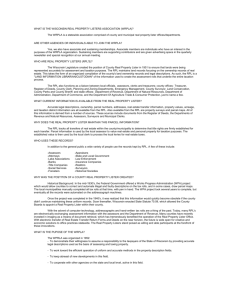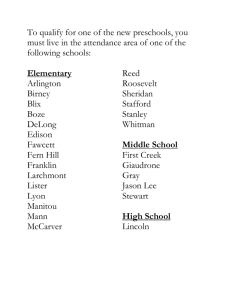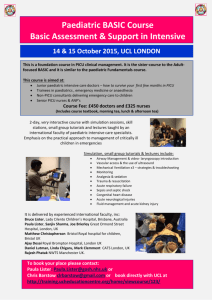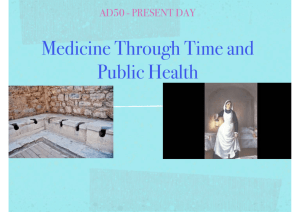Do You Know Your Real Estate Lister? Every County Has One
advertisement
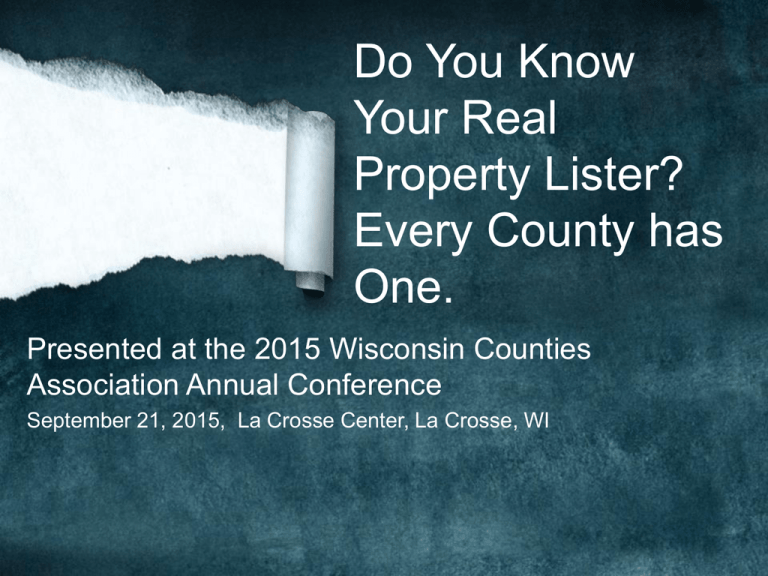
Do You Know Your Real Property Lister? Every County has One. Presented at the 2015 Wisconsin Counties Association Annual Conference September 21, 2015, La Crosse Center, La Crosse, WI Acknowledgements • • • • • • • • James Wallen, Brown County • Roxanne Moore, Burnett Co.-R • Cheryl Zellmer, Dane County • David Addison, Dodge County • Holly Hansen, Door County • Al Brokmeier, Kenosha County • Pam Hollnagel, La Crosse Co. • Lauree Aulik, Lafayette Co. • • Marge Johnson, Lincoln County Ruth Winter, Menominee Co. Jeremy Erickson, Monroe Co. Cindy Wisinski, Portage Co. Pat Harmann, Racine Co. - Ret. Ann Burton Sauk County - Ret. Krista Paulson, Sauk County Nick Gamroth, Trempealeau Co. Brian Braithwaite, Washington Co. PRESENTATION GOALS: • Origins • An understanding of the role of the Real Property Lister Position in County Government • Responsibilities in the assessment cycle and in land records • Relationships with other county offices, local officials and the State of Wisconsin • Knowledge, skills, and training needed for the position • Possible future roles of the position Origins History of Assessing in Wisconsin Elected Local Assessors Elected Local Assessors with County Boards Appointed Perform Equalization State Board of Equalization 1868 County Boards Given Responsibility for Assessments Origins History of Assessing in Wisconsin Statewide Commission 1899 Appointed. Tax Administration must be Performed by Non-elected Professionals Three Person Commission Appointed to Direct Assessments Equalization Added Commission Eventually Becomes the Department of Revenue Origins The Assessor •Enter each parcel on the assessment roll in regular order by government subdivisions with “such certainty as would be sufficient between grantor and grantee in a conveyance of property.” •Elected •Not certified •Shortened legal description The Town Clerk The Treasurer • Created Tax Roll •Billed and collected •Applied mil rate to taxes using the hand each parcel written tax roll. •Total tax roll and •Wrote certificates on deliver to local delinquencies Treasurer •Tax Deeds on •Shortened legal delinquent land descriptions. became impossible no one knew what land was being taxed Origins • A parcel of land located in Government Lot One(1) of Section Twenty-four(24) Township Thirty-nine(39) North, of Range fourteen (14) West, described as follows: Beginning at the point which is 710 feet East and 33 feet South of the Northwest corner of said Section 24, being the northeast corner of a parcel of land described in Volume 91 of Deeds, page 112, as recorded in the office of the Register of Deeds, thence running East and parallel with the North line of said Section a distance of 647 feet, thence South parallel with the West line of said Section 24, a distance of 850 feet, thence West parallel with the North line of said Section 300 feet, more or less to the shore of Bass Lake, thence Northerly and Northwesterly along the shore of Bass Lake to a point South of the Point of beginning, being the Southeast corner of above referenced Volume 91 page 112, thence North parallel with the West line of said section 24 to the point of the beginning. Origins Origins •Works Progress Administration •Wisconsin State Legislature Origins Problems • Mislabeled Fractional Quarters • Mislabeled Government Lots • Omitted Parcels • Incorrect Ownership • Double Assessments • Missing Records Solutions • Better Grantor/Grantee Indexing • Tract Indexes • Parcel Numbers • Parcel Mapping Origins Origins • Designate provision for position – Tax Description Auditors, Tax Description Supervisors, Property Tax Lister, Tax Writing Directors, Tax Commissioners, County Tax Lister, Tax Lister or Clerks and/or Technicians Origins • 1952 – Organizational meeting of County Tax Listing Departments • Appoint committee to develop constitution and by-laws organizing Tax Listers as statewide group – Assume responsibility for accurate legal descriptions – Encourage development of meetings and educational opportunities – Establish uniformity within profession Origins • 1961 – Wisconsin County Tax Lister’s Association and Wisconsin Counties Association requested amendment to Wisconsin State Statute, Chapter 70 • Creation Wisconsin Statue 70.09 – County Real Property Lister position and duties defined – Tax cycle initiated • Establish RPL at county government level • Statutory authority to provide service to protect general welfare and public records The Assessment Process and Relationships with Other Offices Co. Treasurer GIS Maintains parcel maps Generates tax bills, supplies addresses County GIS Assessor Property values RPL Combines legal descriptions, ownership and values Register of Deeds Deeds, CSMs, subdivisions and condominiums DOR Manufacturing values The RPL Workflow: The transfer of ownership Deeds and other data Changes reviewed/ edited Overnight Printing Changes Returned to RPL Corrections Rolls Changed Real Property Lister Parcel mapped per deed or plat Legal description read, Interests/parcel number confirmed Forwarded to GIS Preliminary legal created, interests conveyed other information. Change order sent to GIS Straight Transfer Rolls Changed Split or Combination Delivery to customers: Assessors, C/V/T, County Treasurer, Department Revenue, General Public and other County Offices. Products Created or Derived: Assessment Rolls, Parcel Maps, Sales Data, Tax Bills, Ownership Information and the County Website. Process and Relationships Discovery and Listing Taxation Board of Review Valuation Open Book Process and Relationships • Almost half of Wisconsin's revenue depends on the work of the RPL • State wide estimated 266,000 roll changes Process and Relationships Assessors 1% Clerks 3% Surveyors 6% Planning 6% Register of Deeds 8% Real Property Lister Office 9% Land Information Office 27% County Treasurer 38% Process and Relationships • “Typical” RPL – 15 Years Experience – Make 3,700 Changes to the Roll Annually – Average Office Staff of Two – Commonly Holds a Bachelors Degree – Frequently Possess an Assessors License – May have a Background in the Title Industry An attempt to summarize what a Real Property Lister is… A property lister is not a lawyer, but they have to know real estate law. A property lister is not a land surveyor, but they have to know how to measure land. A property lister is not a cartographer, but they have to know how to make a map. A property lister is not a title examiner, but they have to know how to examine title. A property lister is not a clerk, but they have to know how to develop and apply mill rates for taxation. A property lister is not a register of deeds, but they have to be able to read and interpret deeds. An attempt to summarize what a Real Property Lister is… A property lister is not an assessor, but they have to be well versed in assessment practices. A property lister is not a zoning administrator, but they have to understand zoning ordinances. A property lister is not a planner, but they have to understand planning and land division ordinances. A property lister is not a conservationist, but they have to understand conservation programs. A property lister is not a GIS analyst, but they have to be able to analyze geographic information. ETC. Important Skills for Effective RPLs • Organizational Skills • • Dates and Deadlines Information and Resources • Problem Solving Skills • • • Analyze information for clues or pertinent facts Collate facts and ideas Learning from experience and building upon it • Communication Skills • • Good listener Speak so that people can understand you…or relate to you. • • • • Use of all formats of communication • • • • Use of technical terms Casual verbiage / slang Teachable moments Phone Email Letters Humility • • • Nobody knows everything Everyone makes mistakes Put yourself in others shoes What does the future hold? The role or extent the RPL will play in the future will largely depend upon legislative decisions. •Dependent on statutory changes and state budgetary provisions Influenced by DOR and possibly DOA decisions and programs at the state level. •The most likely influences being assessment related via the DOR or state parcel map. What does the future hold? Consolidated or county wide assessment? •In house or contracted? The future role of an RPL may be that of an information clearing house. Questions?
